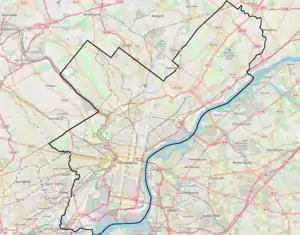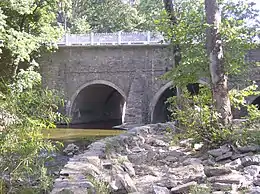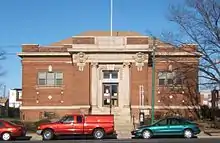Holmesburg, Philadelphia
Holmesburg is a neighborhood in the Northeast section of Philadelphia, Pennsylvania. Holmesburg was named for the descendants of Judge John Holme (1632–1704) who immigrated to Philadelphia in the 1680s and had no apparent relation to Surveyor General Thomas Holme. John Holme's descendants acquired land in Lower Dublin, north and south of Frankford Avenue and west of the Pennypack Creek. At the turn of the 19th century they began selling numerous small parcels of their holdings in what became a real estate boom. Also at this time, John Holme, the great grandson of the first John Holme, renamed his lumber yard the Holmesburg Lumber Yard. This renaming coupled with the multitude of Holme family real estate transactions identified this area as 'Holmesburg', the title surviving more than two hundred years later.
Holmesburg | |
|---|---|
 Saint Dominic Roman Catholic Church, on Frankford Avenue, was established in 1849 | |
 Holmesburg | |
| Coordinates: | |
| Country | |
| State | Pennsylvania |
| County | Philadelphia County |
| City | Philadelphia |
| Area code(s) | 215, 267, and 445 |
It is bordered to the west by Brous Ave. to Ryan Ave. to Sandy Run/Pennypack Creek to Holme Ave. to Holme Circle to Ashton Rd. to Willits Rd, the Delaware River to the east, and Cottman avenue to the south. The border shared with Torresdale to the north is Welsh/Willits/Academy Road and then over to Linden Ave. Holmesburg's ZIP code is 19136.
History
The area around Holmesburg was first inhabited by the Lenape. In 1683 William Penn purchased from the Indians the land between the Pennypack and Neshaminy Creeks. In November 1682, Thomas Holme received a grant from Penn of 1,646 acres (666 ha) on either side of Pennypack Creek to establish Wellspring Plantation. In 1790, his descendants divided the land, and this 26-acre (11 ha) section became known as the Village of Holmesburg.[1]
Penn had the King's Highway Bridge erected over the Pennypack Creek in 1697 to connect his mansion with the new city of Philadelphia. Downstream from the bridge Peter Dale and John Holme built a grist mill. A dam was constructed upstream at "Rocky Falls"; water to turn the mill-wheels was brought from the dam through a long mill-race. Welsh farmers from Gwynedd built a road to bring their grain to the mill. At the end of Welsh Road is Mill Street, which leads to where the mills once stood. When Robert Lewis came into ownership, he added a cooperage for the production of barrels and hogsheads, and this required construction of a sawmill, and probably a cider mill. A bit upstream from the sawmill, David Lewis built a textile mill which was burned during the War of 1812, but subsequently rebuilt.[2] The mills contributed to the growth of Holmesburg.

The first stagecoach service was established in 1756 between Philadelphia and New York. As the trip took three days, this required rest stops. A a blacksmith shop and an inn were established where Welsh Road met the Kings Highway. The Green Tree opened in 1799.[1] U.S. Route 13 between Philadelphia and Morrisville was known as the Frankford and Bristol Turnpike. Ferries had operated near the mouth of the Pennypack from early time. Ferry Lane, (now Pennypack Street) was built to access the Frankford-Bristol Road. In 1803 Holmesburg got its own toll-house and toll-gate, to cover maintenance.
In 1834 the Philadelphia and Trenton Railroad opened. By 1862 a was established at Delaware Avenue (now Rhawn Street). In 1863, the Frankford and Holmesburg Railroad was incorporated to build a line from Frankford to Holmesburg. State Road was opened in 1870. In 1895, the Holmesburg, Tacony and Frankford Company established trolley service; and the road was renamed Frankford Avenue.[2]
Holmesburg native George A. Castor became a successful merchant tailor with large establishments in New York City, Boston, and Philadelphia. He built the eighteen bedroom mansion "Stoneyhurst" on Solly Avenue overlooking the Pennypack Creek. As of 2018, the site was occupied by the motherhouse of the sisters of the Missionary Servants of the Most Blessed Trinity, a Roman Catholic women's congregation, that relocated there in 1931.[3] The congregation was founded by Vincentian Father Timothy A. Judge, for whom Father Judge High School is named.
Shakespearean actor Edwin Forrest purchased 100 acres (40 ha) of land along Frankford Avenue for a country estate. After his death in 1872, his executors turned it into the Forrest Home for retired actors. It operated from about 1876 to 1927.[2] By 1905 lands along the Pennypack had been acquired for parkland.
Act of Consolidation
Around 1701, Lower Dublin Township was established. In 1853, about half the area of the township was separated out into Delaware Township, which comprised Torresdale and Holmesburg. It was superseded the following year by the 1854 Act of Consolidation, 1854 and incorporated into Philadelphia.[4]
Thomas Holme Library

Completed in 1906, the Thomas Holme Library is the smallest of the Philadelphia branch libraries. It was built through an endowment from industrialist Andrew Carnegie. The funds for construction were contingent on the municipality providing the land. The lot was donated by the local Lower Dublin Academy through an endowment established by the Holme family for educational purposes. While originally providing for a school, a library was considered by the trustees and the community to be a significant educational contribution, a concept shared by the Carnegie Corporation. The Thomas Holme Branch was designed by architect Horace W. Castor, of the firm of Sterns & Castor, in the Beaux Arts style.[5] The Free Library of Philadelphia operates the Holmesburg Branch.[6]
Notable people
- George Castor[7] -Congressman
- John Gibbon[8] -Civil War General
Education
The School District of Philadelphia operates Joseph H. Brown Elementary School in Holmesburg.[9] The original Joseph H Brown Elementary School opened in 1895. Brown feeds into Meehan Middle School.[10] All persons assigned to Meehan are zoned to Abraham Lincoln High School.[11] Lincoln was originally scheduled to be named Mayfair High School, but opposition from other neighborhoods, including Holmesburg, meant that the school was instead named after Abraham Lincoln. In 1949 the school's cornerstone was laid.[12]
Saint Dominic Roman Catholic church and grade school are located in Holmesburg. Father Judge High School is also located in Holmesburg. It was established in 1954 by the Roman Catholic Archdiocese of Philadelphia and is run by the Oblates of St. Francis de Sales. Also St. Hubert High School for Girls is in Holmesburg.[13] Holy Family University is planning on constructing buildings at the former Liddonfield Projects site.
Other private or independent schools in Holmesburg, Philadelphia include Holmesburg Christian Academy, which is affiliated with Holmesburg Baptist Church and includes a preschool, elementary school, and middle school.[14]
Prisons
Holmesburg Prison opened in 1896. The Philadelphia Prison System is located in Holmesburg. It includes the Curran-Fromhold Correctional Facility (named for Patrick N. Curran, Warden of old Holmesburg Prison, and Robert F. Fromhold, Deputy Warden, both of whom were murdered in an attack by two inmates on May 31, 1973), the Detention Center, the Philadelphia Industrial Correctional Center, the House of Correction, Riverside Correctional Facility and The Alternative and Special Detention unit. Curran-Fromhold replaced Holmesburg Prison, which was used from 1896 until 1995. Holmesburg Prison was recently reopened. Acres of Skin: Human Experiments at Holmesburg Prison is a 1998 book by Allen Hornblum, which documents clinical non-therapeutic medical experiments on prison inmates at Holmesburg Prison from 1951 to 1974.[15]
Holmesburg contains one of the longest continuous African-American communities in the nation, having been founded by runaway slaves prior to and during the Civil War.
Holmesburg is the location of the historic Pennypack Theatre building, built in 1929 in the Art Deco style with a 1,364-seat capacity and designed by acclaimed 20th century theater architect William Harold Lee.
The Frankford Avenue Bridge and Joseph H. Brown School were added to the National Register of Historic Places in 1988.[16]
Recreation and transportation
Recreational facilities include Holmesburg Recreation Center at Rhawn and Ditman Streets, James Ramp Memorial Playground, Pennypack Park and Pennypack on the Delaware.
Transportation to Center City Philadelphia is provided by SEPTA's Trenton Line commuter train, which affords a quick 25-minute ride into the urban center. Interstate 95 is also an easy 10-15 minute drive into downtown, accessible either by the Cottman Avenue (PA-73) entrance to the south or Academy Road entrance to the north.
Holmesburg's main thoroughfare, Frankford Avenue (U.S. Route 13), is a historic byway in use for centuries. Frankford Avenue was used as a route from Philadelphia to points north as far back as the 17th century. The Frankford Avenue Bridge across Pennypack Creek, built in 1697, is the oldest stone arch bridge in continuous use in the country.
Holmesburg in print and film
Holmesburg Prison was used for three major motion pictures, Up Close & Personal starring Robert Redford and Michelle Pfeiffer, Animal Factory starring Willem Dafoe, Mickey Rourke, and Edward Furlong, and Law Abiding Citizen starring Jamie Foxx, Gerard Butler, and Colm Meany. Parts of the movie Fallen were also filmed here.
References
- "Holmesburg", Preservation Alliance for Greater Philadelphia
- Eleanor P., "Historical Northeast Philadelphia", Friends of the Holmesburg Branch Free Library, 1994
- Baldwin, Lou. "Phila.-based Trinitarian sisters continue work for poor, immigrants", Catholic Philly, September 20, 2018
- Brookes, Karin; John Gattuso; Lou Harry; Edward Jardim; Donald Kraybill; Susan Lewis; Dave Nelson; Carol Turkington (2005). Zoë Ross (ed.). Insight Guides: Philadelphia and Surroundings (Second Edition (Updated) ed.). APA Publications. p. 359. ISBN 1-58573-026-2.
- "Free Library of Philadelphia, Thomas Holme Branch, 7810 Frankford Avenue, Philadelphia, Philadelphia County, PA", Historic American Buildings Survey, Library of Congress
- "Holmesburg Branch." Free Library of Philadelphia. Retrieved on October 19, 2012.
- Castor, George Albert", Biographical Dictionary of the United states Congress
- "Gibbon, John", Dictionary of North Carolina Biography, (William S. Powell, ed.) University of North Carolina Press. 1996
- "About Us Archived 2016-03-05 at the Wayback Machine." J. H. Brown Elementary School. Retrieved on December 10, 2016.
- "Joseph H. Brown Elementary School Geographic Boundaries Archived 2016-12-10 at the Wayback Machine." School District of Philadelphia. Retrieved on December 10, 2016.
- "High School Directory Fall 2017 Admissions" (Archive). School District of Philadelphia. p. 42/70. Retrieved on December 10, 2016.
- Loftus, John (2015-01-28). "Changes in the classroom". Northeast Times. Archived from the original on 2015-08-01. Retrieved 2016-12-10.CS1 maint: bot: original URL status unknown (link)
- Carlin, Sean (2012-08-23). "Faith in plan for Archdiocese's high schools". Philadelphia Inquirer. Archived from the original on 2015-09-22. Retrieved 2019-11-30.
- "Academics." Holmesburg Christian Academy. Retrieved on March 08, 2017.
- Theresa Richardson. Acres of Skin: Human Experiments at Holmesburg Prison (Review) Canadian Journal of History, April 1, 2001.
- "National Register Information System". National Register of Historic Places. National Park Service. July 9, 2010.
External links
| Wikimedia Commons has media related to Holmesburg, Philadelphia. |
- Holmesburg.com
- Historic Photographs of Holmesburg, PhillyHistory.org